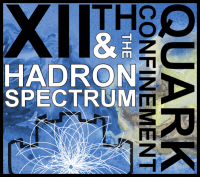Speaker
Description
The main goal of the High Acceptance Di-Electron experiment (HADES) [1] at GSI is the study of hadronic matter in the $1-3.5$ GeV/nucleon incident energy range. The obtained dilepton spectra measured in nucleon-nucleon, nucleon-nucleus and heavy-ion reactions at various beam energies demonstrate important contributions from baryon resonances decays ($R\rightarrow Ne^+e^-$). The resonance-nucleon electromagnetic transitions are described by respective transition form-factors in time-like region which are predicted by various models to be strongly influenced by the intermediate vector mesons (mainly $\rho/\omega$).
In order to directly access such transitions, HADES has started dedicated pion-nucleon programme. For the first time a combined measurement of hadronic and dielectron final states have been performed in $\pi-N$ reactions at four different pion beam momenta (0.656, 0.69, 0.748 and 0.8 GeV/c) [2]. In this measurement two targets (polyethylene $(C_2H_4)_n$ and carbon C) were used with the aim to subtract events from scattering on carbon and identify pure contribution from scattering on protons. Exclusive channels with one pion ($\pi^-p$), two pions ($n \pi^+ \pi^-$ and $p \pi^- \pi^0$) and dileptons ($n e^+ e^-$) in the final state were identified. Exclusive channels with two pions in the final state were put to extend studies in the framework of a partial wave analysis (PWA) of the Bonn-Gatchina group [3] together with the world data on pion and photon production. The obtained solution provides the excitation function of two-pion and photon production around the pole of the $N(1520)D_{13}$ resonance with the decomposition into contributing resonances and in particular the intermediate $\rho$ meson. Next, the obtained $\rho$ contribution has been converted into $e^+e^-$ cross section via strict Vector Dominance Model and compared to the measured exclusive $ne^+e^-$ channel to verify the meson contribution in the resonance-nucleon transition. The results of this analysis will be presented.
[1] G. Agakishiev et al. (HADES), Eur. Phys. J. A 41 (2009) 243.
[2] P. Salabura, J. Stroth, L. Fabbietti (HADES), Nucl. Phys. News 25 (2015) 22
[3] A.V. Anisovich, E. Klempt, A.V. Sarantsev, U. Thoma, Eur. Phys. J. A 24 (2005) 111




